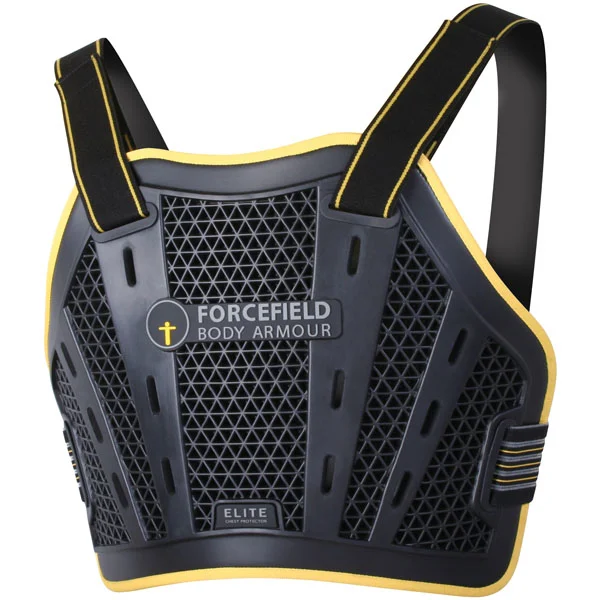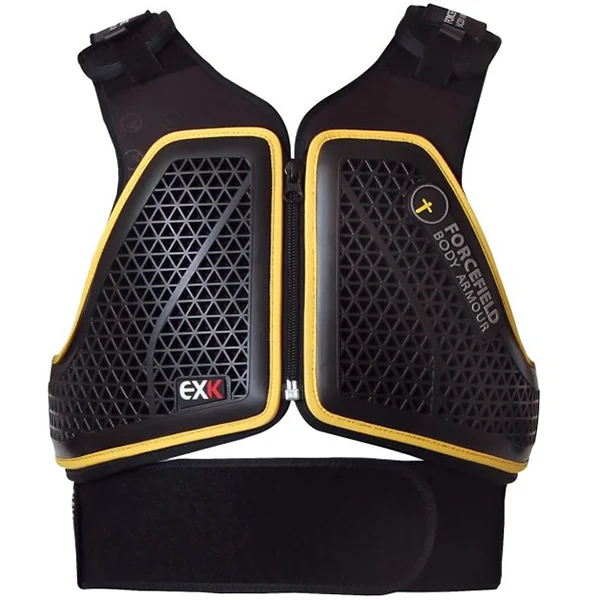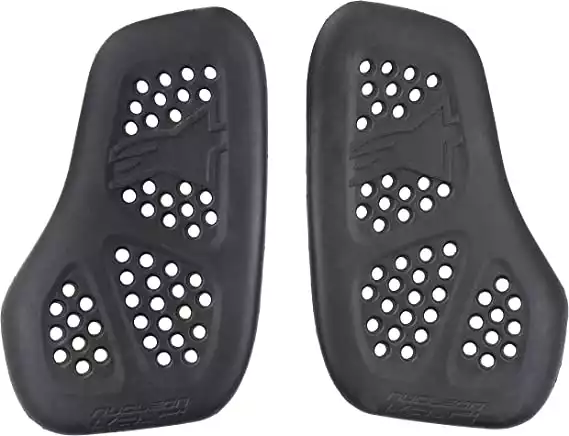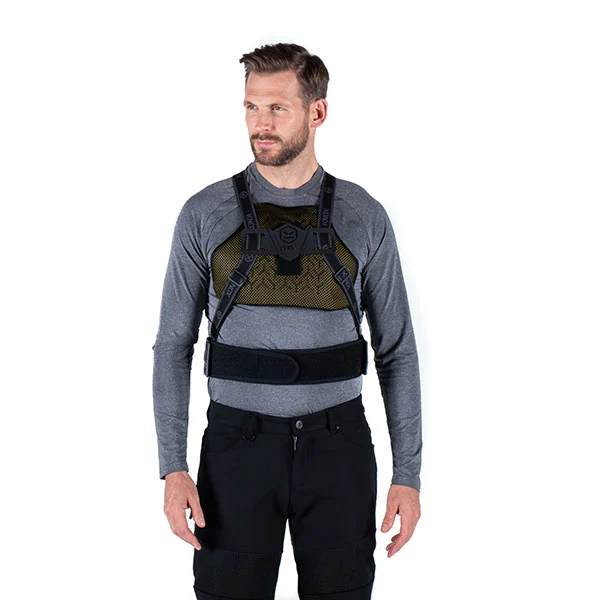Chest protection can often be a shunned cousin of the biker armoury, often seen as a fancy add-on for track or motocross riding.
However, many unfortunate bikers will attest that a forward dive during low-speed impacts can necessitate protection.
Here’s a quick guide to chest protection.
Best Motorcycle Chest Protector Reviews
Let’s take a look at our preferred picks.
Forcefield Elite Chest Protector
This strap-on unit contains Forcefield’s malleable Nitrex Evo material (a lightweight viscoelastic). It comes in two sizes, S-M or L-XL and also has height and width adjustments to tailor it to your needs.
Check Prices on SportsBikeShop
It also boasts ‘Repeat Performance’ technology, which they claim allows the material to recover during an accident to protect from multiple hits (some websites seem to think this technology means you can reuse the product after an accident).
Its honeycomb construction aids ventilation, and lower coverage also protects parts of the sternum. It’s Certified to prEN1621-3:2011 Level 1.
Pros
- Flexible and moulded
- Good coverage of upper and lower chest
- Well vented
Cons
- Only Level 1 certified
- Straps and adjusters can be fiddly
Forcefield EX-K Harness Flite Chest and Back Protector
The EX-K Harness offers total upper body protection with chest and back protection all in one unit. Furthermore, it allows you to add Nitrex shoulder and elbow protection and neck brace compatibility.
Check Prices on SportsBikeShop
As with the Elite Chest protector, the unit boasts Nitrex Evo material and repeat performance technology. The harness system uses an aramid thread to provide good abrasion resistance. It’s available in three sizes.
It contains a central zip opening and velcro straps, making removal a reasonably easy task. It also has adjustable shoulder straps and a velcro belt, offering further kidney protection.
Many users talk about how this product inspires them to feel safe on the road and warrants a greater piece of mind when riding, making this our premium pick.
Pros
- Modular unit can be upgraded with shoulder/elbow armour
- CE Level 2 certified
- Good zip and velcro entry system
Cons
- Not cheap
- Could be a bulky solution for regular riders
- May appeal more to track / off-road enthusiasts
Alpinestars Nucleon KR-Ci Chest Protector
These inserts are designed to be used in several Alpinestars jackets. However, a few people have reported that they fit in some other jackets.
They are slimline and made from Alpinestars’ Nucleon’ viscoelastic polymer, meaning they are lightweight and will shape and mould to your body. They’re perforated as well, so they will vent when warm.
Alpinestars states that the Nucleon is CE Certified to prEN 1621-3:2013.
Pros
- Nucleon material makes them comfortable and unobtrusive
- Offers an upgrade to Alpinestars standard foam inserts
- Perforated surface offers ventilation
Cons
- Could have limited compatibility with non-Alpinestars jackets
- Can make an already tight jacket a bit tighter
- Take time to mould when cold
Knox Micro-Lock Back Protector Chest Upgrade
This add-on unit is designed as an accessory for the Knox Aegis back protector.
Check Prices on SportsBikeShop
Not the most slimline chest protector, but it is CE Level 1 certified and offers a lightweight honeycomb structure.
When connected to the Aegis back protector, it limits its quick-release belt system as the chest protector doesn’t have an opening mechanism, so you have to lift the unit over your head.
When twinned with the Aegis, it offers a high level of all-round armour option at a reasonable price, and I like its looks.
Pros
- CE Level 1 Certified
- Reasonably Priced
- Lightweight and flexible
Cons
- Only fits the Aegis back protector
- Cumbersome to put on / take off
- Can be bulky under leathers
Buyers Guide
Certification
So how is your armour certified?
It is a complex area when you get into the detail, but there are essentially two primary standards that manufacturers can apply to their products:
CE Level 1: The armour has been tested and will provide decent protection for general use.
CE Level 2: Offers almost double the protection of CE1 and, with recent advances in materials technology, can remain light and flexible. Always go for level 2 if you can afford it.
Read more about motorcycle armour.
Inserts or strap-on?
As with all armour, chest protection is available in insert or stand-alone strap-on options.
Inserts
These are best to upgrade existing armour; however, they are not always compatible with every type of jacket (check with the supplier or take your jacket into a store).
Strap-on Armour
It’s less convenient but superior in its ability to hold armour closer to the area it’s protecting.
Other Considerations
Your clothing fit needs to be considered. If your current jacket or race suit is a ‘slim fit’, you may struggle to incorporate a strap-on protector.
If your jacket is loose and you opt for inserts, they will be ineffective and not hold the armour close to your body.
Conclusion
Many riders who buy chest armour have learnt from bitter experience how painful a fall can be when landing on your chest. So if your budget allows, chest armour should be on your list.
Inserts are more convenient, allowing you to armour up without thinking about it. Whereas separates can be bulky, they offer that extra level of protection that many people crave for longer or more adventurous riding trips.
See our other guide: Best Motorcycle Back Protectors




